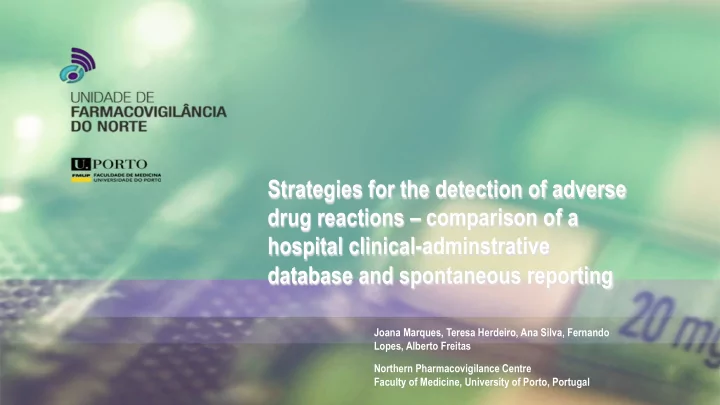

Strategies for the detection of adverse drug reactions – comparison of a hospital clinical-adminstrative database and spontaneous reporting Joana Marques, Teresa Herdeiro, Ana Silva, Fernando Lopes, Alberto Freitas Northern Pharmacovigilance Centre Faculty of Medicine, University of Porto, Portugal
Strategies for the detection of adverse drug reactions Comparison of a hospital clinical-administrative database and spontaneous reporting Context Portugal 10 600 000 inhabitants 3 700 000 inhabitants Northern Region 2011 2014 Health professionals + N N Patients Rate Rate Reports 1303 Hp 2289 Hp+175 P Portugal 122 232 384 Hp 898 Hp+34 P Northern Region 104 252
Strategies for the detection of adverse drug reactions Comparison of a hospital clinical-administrative database and spontaneous reporting Context ADR • Important cause of morbidity and mortality that results in additional costs for health services and an extensive burden for the patient • Estimated that are responsible for hospital admissions, for a significant length of stay in the hospital with an increased risk of death in hospitalized patients
Strategies for the detection of adverse drug reactions Comparison of a hospital clinical-administrative database and spontaneous reporting Context Spontaneous reporting Widespread, simple and efficient method in early detection of ADR Underreporting is a known limitation Missing of essencial information for Drug Underestimation security monitoring of ADRs Find out other strategies to detect more ADR
Strategies for the detection of adverse drug reactions Comparison of a hospital clinical-administrative database and spontaneous reporting Aim Evaluate the potential of a hospital clinical-administrative database to detect adverse drug reactions and how it can contribute to the pharmacovigilance system
Strategies for the detection of adverse drug reactions Comparison of a hospital clinical-administrative database and spontaneous reporting Methods Retrospective study, descriptive analysis to characterize ADRs occurred in a central hospital in the North of Portugal (São João Hospital), year 2011 Episodes of ADR Data Spontaneous reports by health Northern Pharmacovigilance Centre database professionals of episodes occurred in (Health Authority) hospital Hospitalization National Hospital Clinical-Administrative database Outpatient surgery (CAD) Medical clinic held in hospital
Strategies for the detection of adverse drug reactions Comparison of a hospital clinical-administrative database and spontaneous reporting Methods Clinical administrative data (CAD): National database of patient diagnosis related groups (DRG) DRG - Inpatients classification in acute care hospitals of the National Health System that includes the patients in similar groups (coded according to ICD-9-CM) with the perspective of resource consumption (hospital expenses with the patient) for hospital reimbursement.
Strategies for the detection of adverse drug reactions Comparison of a hospital clinical-administrative database and spontaneous reporting Methods 1. We selected the inpatient episodes with potential ADRs, using a set of codes that are usually related to ADRs: - Codes with diagnosis of ADR - “E” codes of an external cause of ADR 2. Approximately 11% were randomly selected for revision by trained medical coders (Chart review)
Strategies for the detection of adverse drug reactions Comparison of a hospital clinical-administrative database and spontaneous reporting Results Northern ¡ Hospital ¡São ¡João Pharmacovigilance ¡Centre (HSJ) (NPC) 44 ¡613 ¡ 384 Inpatient ¡episodes Reports In ¡2011 In ¡2011 1438 Inpatient ¡episodes 244 1993 ¡ (episodes ¡with ¡either ¡an ¡ Reports ¡in ¡hospitals ¡of ¡ ICD9-‑CM ¡codes ¡of ¡ external ¡cause ¡or ¡a ¡diagnosis ¡ the ¡north ¡of ¡Portugal adverse ¡drug ¡events of ¡ICD9-‑CM ¡codes ¡of ¡adverse ¡ drug ¡events) Randomly ¡selected 52 177 153 ¡ Reports ¡in ¡ 200 ¡ADR ICD9-‑CM ¡codes ¡of ¡ Inpatient ¡episodes Hospital ¡São ¡João adverse ¡drug ¡events Chart ¡Reviewed 7 ¡excluded ¡ 170 ¡ 146 242 ¡ADR ICD9-‑CM ¡codes ¡of ¡ Inpatient ¡episodes adverse ¡drug ¡events
Strategies for the detection of adverse drug reactions Comparison of a hospital clinical-administrative database and spontaneous reporting Results Northern Pharmacovigilance centre – Spontaneous Reports ü There were received 52 health professionals reports of ADR episodes that occurred in the São João Hospital, in 2011 After MedDRA coding: ü We identified 200 ADRs
Strategies for the detection of adverse drug reactions Comparison of a hospital clinical-administrative database and spontaneous reporting Results Inpatient episodes chart reviewed of CAD ü 153 inpatient episodes were reviewed ü Of the 177 ICD-9-CM codes identified as potential ADRs, 170 (96%) were actually adverse events related to drugs (ADRs) After MedDRA coding: ü Of the 170 ADRs we identified in fact 242 ADR MedDRA codes ü Only one episode chart reviewed was identified in the pharmacovigilance database (spontaneously reported)
Strategies for the detection of adverse drug reactions Comparison of a hospital clinical-administrative database and spontaneous reports Results
Strategies for the detection of adverse drug reactions Comparison of a hospital clinical-administrative database and spontaneous reports Results Suspected drugs by ATC classification 60 50 40 30 20 10 0 Chart review of CAD Spontaneous Report
Strategies for the detection of adverse drug reactions Comparison of a hospital clinical-administrative database and spontaneous reporting Conclusions ü Hospital clinical-administrative database can be useful in detecting ADRs as a secondary source of information in pharmacovigilance ü The combination of several health databases can give an important contribute to the drug balance benefit-risk
Strategies for the detection of adverse drug reactions Comparison of a hospital clinical-administrative database and spontaneous reporting Conclusions In the future: • Necessary a national study to validate the utility of hospital CAD in the pharmacovigilance system • Possibility to use an icon with a web service that after the approval of the medical expert, transfers the ADR information from these hospital databases to the pharmacovigilance database
Thank You!
Recommend
More recommend